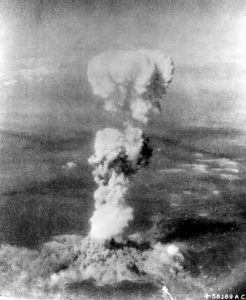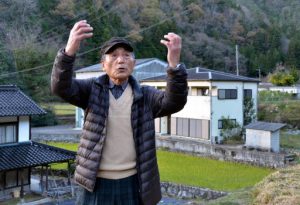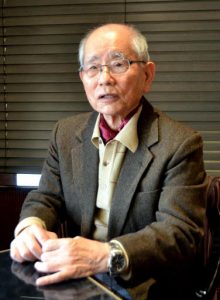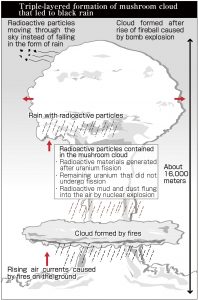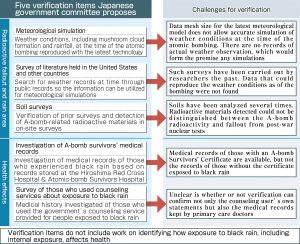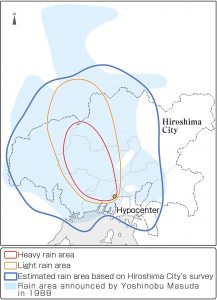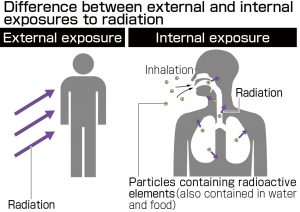Striving to fill voids in Hiroshima 75 years after the atomic bombing—Path toward resolving issue of black rain
Jan. 3, 2021
by Junji Akechi, Staff Writer
On August 6, 1945, the U.S. military dropped an atomic bomb that exploded in the sky above Hiroshima. After the bombing, black rain containing radioactive materials fell over broad areas. Black rain itself is well known, but many points have yet to be clarified regarding actual harm caused by the rain. Responding to a ruling made by the Hiroshima District Court in July last year that recognized those exposed to black rain as being A-bomb survivors, the Japanese government once again kicked off an effort to verify the precise area on which black rain fell. However, the passage of time represents a major obstacle to verification. Why do voids still exist in the story of A-bomb devastation, which includes damage wrought by both direct and indirect exposures to the bombing? In this article, the Chugoku Shimbun covers the testimony by those who have suffered from such voids directly as well as the progress of scientific investigations into the issue of black rain.
Five viewpoints need to be verified—mountain of difficult tasks ahead
Simulations of meteorological conditions might not be accurate: It is difficult for soil surveys to distinguish cause of soil contamination between A-bombings and nuclear tests
In November of last year, to verify the black rain areas, the Japanese government formed a committee of 11 experts. At the committee’s first meeting, five items for verification were proposed, including simulations of the meteorological conditions at the time of the atomic bombings. Starting now, verification work will be undertaken by this working group of researchers, who were selected through an open recruitment process. Nevertheless, a mountain of difficult tasks awaits.
In the committee’s meeting, the government official in charge suggested the first verification effort should be the examination of the rain areas by reproducing meteorological conditions present at the time of the atomic bombings using a super-computer. “Advances in technology might allow new verification,” he remarked. In Europe, data is being compiled to reproduce weather conditions on the earth over the past century. The government’s verification proposal is based on the assumption that such weather simulation data from 1945 could be utilized.
Michio Aoyama, a visiting professor at the University of Tsukuba, said, “I understand the point of simulation work, but it would still be difficult to actually carry out.” Mr. Aoyama was involved in the Hiroshima City government’s survey about the black rain areas that began in 2010. At present, the simulation data’s mesh size is a range in all directions of about 125 kilometers, nearly equal to the area of Hiroshima Prefecture. As the data accuracy is still rough, it would be difficult to utilize for detailed analyses, such as simulation of the mushroom cloud movement.
To obtain historical records of weather observations in Hiroshima Prefecture, Mr. Aoyama checked on numerous documents from the past, including U.S. military records. However, he was unable to find records of such weather observations. Some of the committee members expressed caution about simulations, saying no conclusions could be drawn based only on that work. According to Mr. Aoyama, “Although time and budget are necessary, if local simulation models can be established based on the Setouchi region’s geographical features and weather observation records, we might find out something about localized weather phenomena that occurred after the atomic bombing.”
In identifying the rain area, soil surveys also play an important role to explore whether any radioactive material fell to the ground and its amount, if any. However, since more than 2,000 nuclear tests were conducted around the world after World War II, it would be difficult to distinguish the cause of radioactive soil contamination between A-bomb-related and post-war nuclear test-related contamination. Starting in 2008, Masaharu Hoshi, professor emeritus at Hiroshima University, and other researchers analyzed the soil collected under the floors of private homes erected soon after the atomic bombing until three years later. As a result, radioactive materials were detected from the soil outside the black rain area designated by the Japanese national government as requiring relief by law. The committee will also need to re-evaluate such survey results.
As for research into black rain’s effects on human health, the medical records of about 50,000 A-bomb survivors, now stored at the Hiroshima Red Cross Hospital & Atomic-bomb Survivors Hospital, will be analyzed. Those records include the symptoms patients experienced when they arrived at the hospital, descriptions about the situations they were in when they experienced the atomic bombings, and whether they experienced any external injuries or acute symptoms.
The medical records kept at the hospital are only for those with an A-bomb survivors’ certificate based on their direct experience of the atomic bombing or their having been exposed to radiation after entering the city area in the aftermath of the bombing. Of that total, fewer than 100 survivors’ records include descriptions indicating they had also been exposed to black rain. Megumu Fujiwara, director of the hospital’s diagnostic pathology department, said, “There is a limit to what we can do, but we will do as much analysis as possible.”
The only verification work to be carried out on those who experienced black rain is a survey of people who utilized the national government’s health counseling services regarding black rain. This verification will include analysis of users’ statements about their health at the time of counseling and cross-checking of their data with the prefecture’s cancer patient records. The government’s attitude is certain to be tested in terms of how comprehensively the survey can be carried out, such as information-gathering from primary care doctors and re-verification of medical histories.
As for the issue of internal radiation exposure caused by black rain, Yasuhito Sasaki, chairman of the committee and director of the radiotherapy research center at Shonan Kamakura General Hospital, said simply, “Opinions among us differ, and we need to sort them out sometime in the future.” One of the committee members suggested that verification be done from the perspective of effects that radioactive particles have on human health.
Radioactive materials fell from mushroom cloud
“I was looking up at the mushroom cloud as it rose, turned inside out, and stretched out over the sky,” said Kanji Doi, 89, a resident of the Tomota area in Hatsukaichi, while wriggling his fingers on both hands in front of his face. Mr. Doi worked to try and find the exact words to describe how the mushroom cloud came up over the mountains from the direction of Hiroshima. It was a sunny day, but he witnessed the mushroom cloud moving sideways across the sky with flashes of lightening and black rain falling around the present-day Saeki Ward area.
The mushroom cloud was formed by the A-bomb explosion and reached around 16,000 meters in the sky. There were primarily three sources of cloud formation, and it is thought that each generated rain with radioactive materials. First, a cloud arose from the fireball that was generated after the explosion. After the atomic bomb exploded 600 meters aboveground, the fireball with intense heat ballooned and rose into the sky. It gradually cooled and turned into a cloud, which made up the so-called “cap” part of the mushroom cloud.
Meanwhile, the ground was hit by a shockwave from the explosion that flung dust and wreckage from collapsed houses into the air, leading to the formation of a dust cloud. Another cloud was created by the fires that incinerated an area within around a two-kilometer radius from the hypocenter. Those clouds are assumed to have comprised the middle and bottom portions of the mushroom cloud.
The cloud contained many fine radioactive particles, including radioactive substances such as cesium generated by the fission of uranium, a raw material of the atomic bomb, uranium that did not achieve fission, and dust and soot that contained radiation, for example.
Such radioactive particles fell over a large area as rain or dispersed into the atmosphere as dry particles. Some have pointed out the possibility that internal exposure might have occurred among residents in the area through not only radiation from rain and wet ground surfaces but also through the intake of water and food contaminated with radioactive materials.
Physical and psychological pain is still not healed amid continued struggle to expand black rain area covered by national relief law
On a mountainous road in the village of Yuki-cho in Hiroshima’s Saeki Ward, located around 20 kilometers from the hypocenter to the northwest, Masaaki Takano, 82, looked up at the sky. “On my way from school, burnt pieces of paper and wood were falling from the sky, and then there was black rain,” said Mr. Takano. He was a first-year student at a branch of a national school. After he encountered rain near his home, he suffered symptoms such as high fever, diarrhea, and hair loss. Now, he suffers from cancer and cataract.
Immediate diarrhea and fatigue, long-lasting anemia, and the development of cancer later in life. Those symptoms are commonly seen in many of those who were exposed to the black rain or ate vegetables and drank water contaminated by the rain. Mr. Takano said, “I think only black rain is to blame for my condition.” He now serves as the lead plaintiff in a lawsuit that has been filed against the Japanese national government.
How broadly the black rain actually fell, however, and what effect the rain had on human health are not completely understood.
According to surveys conducted to date, black rain fell in Hiroshima between around 9:00 a.m. and 3:00 p.m. The national government, however, has designated only those exposed in the heavy rain area, an oval-shaped area of about 19 kilometers in length and 11 kilometers in width, as eligible to receive relief by law. The boundary designation was based on the results of interviews conducted by six engineers from the Hiroshima District Meteorological Observatory (now Hiroshima Local Meteorological Observatory), including Michitaka Uda, in the chaos of post A-bombing Hiroshima.
After that, new surveys were repeatedly implemented to verify the black rain area. In 1988, Yoshinobu Masuda, 97, former laboratory chief at the Meteorological Agency’s Meteorological Research Institute, announced that the rainfall area was much larger than the currently designated one, based on on-site interviews and analysis of personal notes written by survivors. Additionally, the Hiroshima City government reported results from a 2010 survey, concluding that the rainfall area was about six-times larger than the typically agreed-upon “heavy rain area.” Megu Otaki, professor emeritus at Hiroshima University who at the time belonged to the university’s Research Institute for Radiation Biology and Medicine, thoroughly analyzed the responses to the survey from 1,565 people who described where and when they had experienced the rain from among about 37,000 residents of Hiroshima Prefecture who participated in the survey.
The late Isao Kita (who died at the age of 89 in 2001), who also participated in Mr. Uda and other engineers’ surveys, said that the rain area identified at that time had been tentatively decided. In fact, Mr. Masuda and the city have presented an updated rain area based on larger-scale research than that conducted by Mr. Uda, but the Japanese government has continued rejecting the claims.
As for deterioration of health because of exposure to black rain, the Army Medical School preserved records from October 1945. The school examined six residents in the area of Furue (now part of Nishi Ward) who had been exposed to rain. All complained of fatigue, and some said they suffered hair loss or bloody spots appearing on the skin. The examiner wrote that while it was difficult to draw any conclusions due to the small sample size, it was possible to attribute the residents’ symptoms to the rain. Mr. Uda and other engineers also reported that many cases of long-lasting diarrhea were observed among residents in the areas of Koi and Takasu (both now part of Nishi Ward), suggesting that people had been affected by well-water into which the rainwater flowed.
Yuriko Taniguchi, 80, a resident of Saeki Ward, said, “I believe there must have been a different kind of exposure to radiation than only direct exposure.” Ms. Taniguchi experienced black rain when she was four and developed cancer five years ago. She is not involved in the lawsuit but has a sense of distrust regarding the case made by the Japanese government. She added, “I think the government has underestimated the damage caused by the atomic bombings and risks inherent in nuclear weapons.”
Possibility of internal radiation exposure has been underestimated Stories of those who experienced rainfall must be heeded
What does it take for a picture of the black rain to be assembled? We conducted an interview with Nanao Kamada, 83, a member of a national government’s deliberative committee and professor emeritus at Hiroshima University who has studied the aftereffects of radiation exposure over many years.
Do you think the black rain had any effect on human health?
Yes, it must have had an impact. The possibility of internal radiation exposure from radioactive substances were taken into bodies has been underestimated. It would take time for aftereffects to appear, but the mechanisms and characteristics of such exposure have not yet been identified. Studies conducted to date seem to have drawn conclusions too quickly.
You also served as member of the experts’ meeting held by Hiroshima City and Prefecture in 1988, right?
At that time, I felt my mission was to do research on people who had been exposed to the huge amount of radiation at short distances from the hypocenter, and in that way, I neglected other kinds of radiation exposures. I was inexperienced and lacked knowledge. Now, I have a different perspective.
What made you change your way of thinking?
When I was director of a nursing home for A-bomb survivors, I met a woman who had lived in Furuta-machi (now part of Nishi Ward) where black rain fell in the aftermath of the atomic bombing. She was 29 years old at the time of the bombing and lived about 4.1 kilometers from the hypocenter. As she had just given birth to a baby, she could not go outside. For about two weeks after the bombing, she ate vegetables grown near her home and drank water drawn from a well in the neighborhood.
In her eighties, she developed cancer of the lung, stomach, and colon. When I checked the cancer cells in her lungs, I found there was a trace of radiation seemingly emitted from uranium. I became confident that she had experienced internal radiation exposure.
What is needed to identify the true situation surrounding black rain?
Thus far, we have focused on research into understanding trends in study populations, and individual cases were treated like grains of sand. But as a physician, I now believe it is important to have the perspective of a clinician. The late Gensaku Oho (who died in 1992 at the age of 87) was the first person to recognize the increase in cases of cancers among the A-bomb survivors. Mr. Oho probed deeper into the strange sense he felt from the diagnosis and treatment he experienced over time and uncovered the reality. Without prejudgment, we first must listen attentively to the words of people who experienced the rain.
The verification process to be carried out this time will be the last chance for those who had been exposed to black rain. After the nuclear accident in March 2011 at the Tokyo Electric Power Company’s Fukushima No.1 (Daiichi) nuclear power plant, we discovered that radioactive materials accumulated in pools of rainwater or flew off in the distance on the wind. Making use of such observations, we have to conduct thorough debate about the black rain issue with open minds.
Nanao Kamada
Graduated from the School of Medicine at Hiroshima University (HU). Served in such posts such as HU’s director of the Research Institute for Radiation Biology and Medicine and chair of the Hiroshima International Council for Health Care of the Radiation-exposed (HICARE). Retired as director of the Hiroshima A-bomb Survivors Relief Foundation in March 2017. Specialist in hematologic internal medicine.
(Originally published on January 3, 2021)
On August 6, 1945, the U.S. military dropped an atomic bomb that exploded in the sky above Hiroshima. After the bombing, black rain containing radioactive materials fell over broad areas. Black rain itself is well known, but many points have yet to be clarified regarding actual harm caused by the rain. Responding to a ruling made by the Hiroshima District Court in July last year that recognized those exposed to black rain as being A-bomb survivors, the Japanese government once again kicked off an effort to verify the precise area on which black rain fell. However, the passage of time represents a major obstacle to verification. Why do voids still exist in the story of A-bomb devastation, which includes damage wrought by both direct and indirect exposures to the bombing? In this article, the Chugoku Shimbun covers the testimony by those who have suffered from such voids directly as well as the progress of scientific investigations into the issue of black rain.
Renewed verification work
National government establishes committee for verification efforts
Five viewpoints need to be verified—mountain of difficult tasks ahead
Simulations of meteorological conditions might not be accurate: It is difficult for soil surveys to distinguish cause of soil contamination between A-bombings and nuclear tests
In November of last year, to verify the black rain areas, the Japanese government formed a committee of 11 experts. At the committee’s first meeting, five items for verification were proposed, including simulations of the meteorological conditions at the time of the atomic bombings. Starting now, verification work will be undertaken by this working group of researchers, who were selected through an open recruitment process. Nevertheless, a mountain of difficult tasks awaits.
In the committee’s meeting, the government official in charge suggested the first verification effort should be the examination of the rain areas by reproducing meteorological conditions present at the time of the atomic bombings using a super-computer. “Advances in technology might allow new verification,” he remarked. In Europe, data is being compiled to reproduce weather conditions on the earth over the past century. The government’s verification proposal is based on the assumption that such weather simulation data from 1945 could be utilized.
Michio Aoyama, a visiting professor at the University of Tsukuba, said, “I understand the point of simulation work, but it would still be difficult to actually carry out.” Mr. Aoyama was involved in the Hiroshima City government’s survey about the black rain areas that began in 2010. At present, the simulation data’s mesh size is a range in all directions of about 125 kilometers, nearly equal to the area of Hiroshima Prefecture. As the data accuracy is still rough, it would be difficult to utilize for detailed analyses, such as simulation of the mushroom cloud movement.
To obtain historical records of weather observations in Hiroshima Prefecture, Mr. Aoyama checked on numerous documents from the past, including U.S. military records. However, he was unable to find records of such weather observations. Some of the committee members expressed caution about simulations, saying no conclusions could be drawn based only on that work. According to Mr. Aoyama, “Although time and budget are necessary, if local simulation models can be established based on the Setouchi region’s geographical features and weather observation records, we might find out something about localized weather phenomena that occurred after the atomic bombing.”
In identifying the rain area, soil surveys also play an important role to explore whether any radioactive material fell to the ground and its amount, if any. However, since more than 2,000 nuclear tests were conducted around the world after World War II, it would be difficult to distinguish the cause of radioactive soil contamination between A-bomb-related and post-war nuclear test-related contamination. Starting in 2008, Masaharu Hoshi, professor emeritus at Hiroshima University, and other researchers analyzed the soil collected under the floors of private homes erected soon after the atomic bombing until three years later. As a result, radioactive materials were detected from the soil outside the black rain area designated by the Japanese national government as requiring relief by law. The committee will also need to re-evaluate such survey results.
As for research into black rain’s effects on human health, the medical records of about 50,000 A-bomb survivors, now stored at the Hiroshima Red Cross Hospital & Atomic-bomb Survivors Hospital, will be analyzed. Those records include the symptoms patients experienced when they arrived at the hospital, descriptions about the situations they were in when they experienced the atomic bombings, and whether they experienced any external injuries or acute symptoms.
The medical records kept at the hospital are only for those with an A-bomb survivors’ certificate based on their direct experience of the atomic bombing or their having been exposed to radiation after entering the city area in the aftermath of the bombing. Of that total, fewer than 100 survivors’ records include descriptions indicating they had also been exposed to black rain. Megumu Fujiwara, director of the hospital’s diagnostic pathology department, said, “There is a limit to what we can do, but we will do as much analysis as possible.”
The only verification work to be carried out on those who experienced black rain is a survey of people who utilized the national government’s health counseling services regarding black rain. This verification will include analysis of users’ statements about their health at the time of counseling and cross-checking of their data with the prefecture’s cancer patient records. The government’s attitude is certain to be tested in terms of how comprehensively the survey can be carried out, such as information-gathering from primary care doctors and re-verification of medical histories.
As for the issue of internal radiation exposure caused by black rain, Yasuhito Sasaki, chairman of the committee and director of the radiotherapy research center at Shonan Kamakura General Hospital, said simply, “Opinions among us differ, and we need to sort them out sometime in the future.” One of the committee members suggested that verification be done from the perspective of effects that radioactive particles have on human health.
Mechanisms of black rain’s development
Radioactive materials fell from mushroom cloud
“I was looking up at the mushroom cloud as it rose, turned inside out, and stretched out over the sky,” said Kanji Doi, 89, a resident of the Tomota area in Hatsukaichi, while wriggling his fingers on both hands in front of his face. Mr. Doi worked to try and find the exact words to describe how the mushroom cloud came up over the mountains from the direction of Hiroshima. It was a sunny day, but he witnessed the mushroom cloud moving sideways across the sky with flashes of lightening and black rain falling around the present-day Saeki Ward area.
The mushroom cloud was formed by the A-bomb explosion and reached around 16,000 meters in the sky. There were primarily three sources of cloud formation, and it is thought that each generated rain with radioactive materials. First, a cloud arose from the fireball that was generated after the explosion. After the atomic bomb exploded 600 meters aboveground, the fireball with intense heat ballooned and rose into the sky. It gradually cooled and turned into a cloud, which made up the so-called “cap” part of the mushroom cloud.
Meanwhile, the ground was hit by a shockwave from the explosion that flung dust and wreckage from collapsed houses into the air, leading to the formation of a dust cloud. Another cloud was created by the fires that incinerated an area within around a two-kilometer radius from the hypocenter. Those clouds are assumed to have comprised the middle and bottom portions of the mushroom cloud.
The cloud contained many fine radioactive particles, including radioactive substances such as cesium generated by the fission of uranium, a raw material of the atomic bomb, uranium that did not achieve fission, and dust and soot that contained radiation, for example.
Such radioactive particles fell over a large area as rain or dispersed into the atmosphere as dry particles. Some have pointed out the possibility that internal exposure might have occurred among residents in the area through not only radiation from rain and wet ground surfaces but also through the intake of water and food contaminated with radioactive materials.
Current situation of people who experienced black rain
Physical and psychological pain is still not healed amid continued struggle to expand black rain area covered by national relief law
On a mountainous road in the village of Yuki-cho in Hiroshima’s Saeki Ward, located around 20 kilometers from the hypocenter to the northwest, Masaaki Takano, 82, looked up at the sky. “On my way from school, burnt pieces of paper and wood were falling from the sky, and then there was black rain,” said Mr. Takano. He was a first-year student at a branch of a national school. After he encountered rain near his home, he suffered symptoms such as high fever, diarrhea, and hair loss. Now, he suffers from cancer and cataract.
Immediate diarrhea and fatigue, long-lasting anemia, and the development of cancer later in life. Those symptoms are commonly seen in many of those who were exposed to the black rain or ate vegetables and drank water contaminated by the rain. Mr. Takano said, “I think only black rain is to blame for my condition.” He now serves as the lead plaintiff in a lawsuit that has been filed against the Japanese national government.
How broadly the black rain actually fell, however, and what effect the rain had on human health are not completely understood.
According to surveys conducted to date, black rain fell in Hiroshima between around 9:00 a.m. and 3:00 p.m. The national government, however, has designated only those exposed in the heavy rain area, an oval-shaped area of about 19 kilometers in length and 11 kilometers in width, as eligible to receive relief by law. The boundary designation was based on the results of interviews conducted by six engineers from the Hiroshima District Meteorological Observatory (now Hiroshima Local Meteorological Observatory), including Michitaka Uda, in the chaos of post A-bombing Hiroshima.
After that, new surveys were repeatedly implemented to verify the black rain area. In 1988, Yoshinobu Masuda, 97, former laboratory chief at the Meteorological Agency’s Meteorological Research Institute, announced that the rainfall area was much larger than the currently designated one, based on on-site interviews and analysis of personal notes written by survivors. Additionally, the Hiroshima City government reported results from a 2010 survey, concluding that the rainfall area was about six-times larger than the typically agreed-upon “heavy rain area.” Megu Otaki, professor emeritus at Hiroshima University who at the time belonged to the university’s Research Institute for Radiation Biology and Medicine, thoroughly analyzed the responses to the survey from 1,565 people who described where and when they had experienced the rain from among about 37,000 residents of Hiroshima Prefecture who participated in the survey.
The late Isao Kita (who died at the age of 89 in 2001), who also participated in Mr. Uda and other engineers’ surveys, said that the rain area identified at that time had been tentatively decided. In fact, Mr. Masuda and the city have presented an updated rain area based on larger-scale research than that conducted by Mr. Uda, but the Japanese government has continued rejecting the claims.
As for deterioration of health because of exposure to black rain, the Army Medical School preserved records from October 1945. The school examined six residents in the area of Furue (now part of Nishi Ward) who had been exposed to rain. All complained of fatigue, and some said they suffered hair loss or bloody spots appearing on the skin. The examiner wrote that while it was difficult to draw any conclusions due to the small sample size, it was possible to attribute the residents’ symptoms to the rain. Mr. Uda and other engineers also reported that many cases of long-lasting diarrhea were observed among residents in the areas of Koi and Takasu (both now part of Nishi Ward), suggesting that people had been affected by well-water into which the rainwater flowed.
Yuriko Taniguchi, 80, a resident of Saeki Ward, said, “I believe there must have been a different kind of exposure to radiation than only direct exposure.” Ms. Taniguchi experienced black rain when she was four and developed cancer five years ago. She is not involved in the lawsuit but has a sense of distrust regarding the case made by the Japanese government. She added, “I think the government has underestimated the damage caused by the atomic bombings and risks inherent in nuclear weapons.”
Interview with Nanao Kamada, professor emeritus at Hiroshima University and member of the national government’s deliberative committee
Possibility of internal radiation exposure has been underestimated Stories of those who experienced rainfall must be heeded
What does it take for a picture of the black rain to be assembled? We conducted an interview with Nanao Kamada, 83, a member of a national government’s deliberative committee and professor emeritus at Hiroshima University who has studied the aftereffects of radiation exposure over many years.
Do you think the black rain had any effect on human health?
Yes, it must have had an impact. The possibility of internal radiation exposure from radioactive substances were taken into bodies has been underestimated. It would take time for aftereffects to appear, but the mechanisms and characteristics of such exposure have not yet been identified. Studies conducted to date seem to have drawn conclusions too quickly.
You also served as member of the experts’ meeting held by Hiroshima City and Prefecture in 1988, right?
At that time, I felt my mission was to do research on people who had been exposed to the huge amount of radiation at short distances from the hypocenter, and in that way, I neglected other kinds of radiation exposures. I was inexperienced and lacked knowledge. Now, I have a different perspective.
What made you change your way of thinking?
When I was director of a nursing home for A-bomb survivors, I met a woman who had lived in Furuta-machi (now part of Nishi Ward) where black rain fell in the aftermath of the atomic bombing. She was 29 years old at the time of the bombing and lived about 4.1 kilometers from the hypocenter. As she had just given birth to a baby, she could not go outside. For about two weeks after the bombing, she ate vegetables grown near her home and drank water drawn from a well in the neighborhood.
In her eighties, she developed cancer of the lung, stomach, and colon. When I checked the cancer cells in her lungs, I found there was a trace of radiation seemingly emitted from uranium. I became confident that she had experienced internal radiation exposure.
What is needed to identify the true situation surrounding black rain?
Thus far, we have focused on research into understanding trends in study populations, and individual cases were treated like grains of sand. But as a physician, I now believe it is important to have the perspective of a clinician. The late Gensaku Oho (who died in 1992 at the age of 87) was the first person to recognize the increase in cases of cancers among the A-bomb survivors. Mr. Oho probed deeper into the strange sense he felt from the diagnosis and treatment he experienced over time and uncovered the reality. Without prejudgment, we first must listen attentively to the words of people who experienced the rain.
The verification process to be carried out this time will be the last chance for those who had been exposed to black rain. After the nuclear accident in March 2011 at the Tokyo Electric Power Company’s Fukushima No.1 (Daiichi) nuclear power plant, we discovered that radioactive materials accumulated in pools of rainwater or flew off in the distance on the wind. Making use of such observations, we have to conduct thorough debate about the black rain issue with open minds.
Nanao Kamada
Graduated from the School of Medicine at Hiroshima University (HU). Served in such posts such as HU’s director of the Research Institute for Radiation Biology and Medicine and chair of the Hiroshima International Council for Health Care of the Radiation-exposed (HICARE). Retired as director of the Hiroshima A-bomb Survivors Relief Foundation in March 2017. Specialist in hematologic internal medicine.
(Originally published on January 3, 2021)

